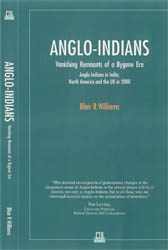
| Invitation |
| Schedule |
| Films |
| Books |
| Photos |
| Press Release |
| Reviews |
The Anglo-Indian Festival of New York |
||
|
||
| Synopsis | ||
| "Anglo-Indians - Vanishing Remnants of a Bygone Era" is based on research conducted by Blair Williams in India, the UK and North America from 1999 to 2001. The central question asked was, "In the 21st Century, are Anglo-Indians merging into the mainstream of the country where they are now domiciled?" "How or why not?" Being an engineer by education and occupation (as distinct from a sociologist), Williams uses statistics extensively and allows the evidence to determine conclusions. He examines cultural, social and psychological factors that determine, influence and reflect the stage of integration. Factors such as inter-marriage, friends, language, education, socio-economic status, self-identity and so on, are all examined and the current status of each is documented. |
||
| Review Margaret Deefholts | ||
| I think you have been very successful in what you set out to do - i.e., compiling a significant watershed study of the Community's attitudes, mores and patterns of social integration at the point of the millennium. In addition it is an absorbing read, and one which will be of overwhelming interest to the Community world-wide, not to mention its value in the broader based field of sociological studies. I have no doubt whatsoever that it will sell-out very quickly and I'm very proud to have had the privilege of seeing this take shape during the gestation process. Thank you for your gracious acknowledgement in the preface, (which was out of all proportion to my minuscule contribution!) and my heartfelt congratulations on presenting a complexity of material in such a cohesive, precise and clear-cut form. I think the Community owes you a huge vote of thanks for all the hard work and dedication that has gone into a publication which we can all regard with pride as a fascinating commentary on "our" past, present and future. And finally, but very far from least, the most laudable thing of all, is that its success will benefit those who need it most - the destitute folks on the streets of Calcutta. Bravo Blair! Margaret Deefholts Author of "Haunting India" Freelance Travel Writer Canada |
||
| Review - Nat Levine | ||
It is not often that a study of ethnic integration into a larger society is performed in great quantitative detail. Yet that is what Professor Williams has done in undertaking to understand the state of integration of Anglo-Indians in three countries, India, the U.K. and North America. |
||
